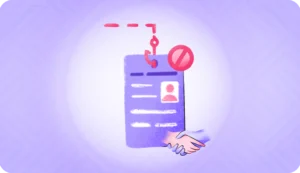The repercussions of identity theft in a business are long-lasting and disastrous.
Every data breach results in customer loss. Every phishing attack damages reputation and every account takeover leads to financial loss.
You get the gist.
Identity theft statistics suggest that in 2023, the Federal Trade Commission filed more than a million reports of identity theft.
According to research by identitytheft.org, out of 5.7 million fraud cases reported to the Federal Trade Commission (FTC), 1.4 million (25%) were exclusively identity theft cases.
That brings us to the problem, how do you navigate identity theft situations in your business?
For starters, you need to understand the common types of identity theft and understand the measures to prevent them.
The following article walks you through how to prevent identity theft in a business in detail. Let’s explore these steps and ensure your clients’ trust is intact in this ever-evolving digital world.
What is identity theft?
Identity theft is a type of crime in which someone wrongfully obtains and uses another individual’s personal data for their own benefit and financial gains. Identity theft can take many forms, such as stealing a Social Security Number (SSN), bank account number, or credit card details. The stolen information is then used to make unauthorized purchases, open new accounts, or access sensitive accounts.
Identity theft is one of the most common types of fraud and can pose severe consequences for a business. It can lead to legal liabilities, loss of customer trust, and significant financial and reputational damage. To combat it, businesses use an identity verification tool to ensure the utmost security while onboarding new customers.
How does an identity theft occur in a business?
Businesses have always been vulnerable to identity theft. However, the rise of AI and deepfakes has significantly increased the risk of fraud and identity theft lately. Identity theft statistics also mention that most identity theft cases occur in the banking and fintech industries as it affects 94% of organizations.
Cybercriminals are becoming more sophisticated in their methods of stealing identities. Let’s check out some of the top ways identity thefts occur in a business.
1. Phishing attack
Ever received an email from your boss or a family member urgently asking you to transfer money? These emails trick you into revealing sensitive information or sending money to the sender. They look legitimate and come from a trusted source, so you end up doing what’s asked and fall prey to fraud.
That’s a phishing attack for you. It is when someone sends a message via an email or text pretending to be from a valid company. They usually ask for personal information, such as passwords or credit card numbers, and use this information to access accounts or make purchases in the victim’s name. Phishing attacks are a part of the broader scheme of identity crimes that fall into social engineering.
2. Social engineering
Social engineering is a manipulation technique that cybercriminals use to psychologically trick individuals into sharing sensitive data or actions that compromise security. They aim to commit a crime using human vulnerabilities rather than technical weaknesses.
Social engineering includes sending targeted emails or in-person interactions that are focused on specific individuals in an organization. Some of the top methods of social engineering include tailgating, pharming, CEO fraud, and pretexting.
3. Synthetic identity theft
This type of fraud involves creating a fake identity by combining real and fabricated information. For instance, they may use one person’s social security number combined with the date of birth and address of a different individual. Synthetic identity fraud is extremely difficult to track and puts many people at risk.
While all the information is correct, no actual person has that identity. Identity thieves can also create fake identity proofs using real details from credit reports or bank statements and use that identity to commit illegal activities. Such thefts can go undetected for a long time and can cause significant harm and financial damage to businesses and financial institutions. The only way you can combat synthetic identity theft is by using an advanced fraud detection system.
4. Financial identity theft
Financial identity theft happens when a cybercriminal or a hacker illegally obtains and uses another person’s or company’s financial information like credit card numbers of customers, bank account numbers, or social security numbers to commit fraud.
The criminal can then use these financial details to make purchases, withdraw money, and open a new account in the victim’s name. The consequences for the victim and the company can be severe, leading to financial losses, damaged credit ratings, and extensive efforts to restore their financial identity.
5. Employment identity theft
Job applications are already draining. Now, imagine someone else using all your professional information and qualifications to apply for a job. Absurd, isn’t it?
Employment identity theft occurs when someone uses someone else’s personal details or social security numbers to apply for a job. The fraudsters are usually people with questionable backgrounds or histories.
The victims then end up with tax liabilities for the income they didn’t earn, face complications in receiving their benefits, and even have trouble getting a job for themselves, ultimately damaging their employment history. The employer faces the consequences in terms of paying an underqualified talent and even bears the risk of employing a fraudster, which can lead to legal consequences.
6. Credit card fraud
One of the most common types of financial fraud is credit card fraud, which involves the unauthorized use of someone else’s credit card to purchase goods or services. The crime happens through physical theft of the card, online transactions with stolen credentials, and skimming devices on ATMs.
Perpetrators can also use the stolen credit card to apply for new credit cards, and the victims can face financial losses, potential damage to credit scores, and incur costs for rectifying fraudulent charges. You can detect credit card fraud using risk scoring and card security features.
7. Deepfake fraud
The latest addition to the list of identity fraud in a business is deepfake fraud. The word deepfake is a combination of “deep learning and fake.” It is a piece of media created with the help of artificial intelligence to mimic a person’s likeness or voice.
Deepfake fraud works by manipulating an audio track, a video, or a combination of both to make it seem authentic. The worst part is, it’s becoming increasingly hard to tell apart from the real thing.
With this ability, identity thieves can use deepfakes to impersonate individuals and deceive people into giving away sensitive information. The only way to fight such fraud is through highly advanced facial recognition and liveliness checks that verify the presence of a person in real-time.
Another way to detect deepfake fraud is by using AI-based deepfake detection that goes beyond liveness. Advanced deepfake detection tools are trained to catch minor anomalies like image injection, video injection, inconsistent eye, and lip movements, etc. making it easy to identify deepfake scams and prevent fraud.
How to prevent business identity theft
Now that you know what are different types of identity theft, let’s check out the methods to combat them.
1. Employ trustworthy fraud detection tools
Identity thefts will only get more advanced, and deepfake fraud is proof of that. The only action you can take is to stay a step ahead with fraud detection tools that provide an end-to-end identity verification solution to detect fraud and prevent business identity theft. These include
- AI-powered Optical Character Recognition (OCR) for document verification,
- No-code workflows for automating identity verification for customer onboarding,
- Deepfake detection and liveness checks for accurate identity verification and
- KYC & AML checks from a central database
Identity verification solutions incorporate data from numerous sources, such as geolocation and device fingerprints, which allows for a proactive monitoring approach and mitigates risks associated with identity fraud.
Having the right fraud detection tools significantly helps you keep your fraudulent activities in check. They also leverage advanced algorithms and machine learning to detect anomalies that deviate from regular behavior, like unusual login locations or rapid, high-value transactions.
2. Perform document verification
Document forgery cases are common in the financial services and education industries. They’re a white-collar crime that involves modifying an existing document to create a fake one. The best way to fight document fraud is by using a highly accurate document verification system that scans and analyzes the document using AI-powered OCR.
For example, banks and lenders have to approve numerous loans regularly. Research suggests banks and lenders take at least 35 to 40 days to approve documents as they have to determine the creditworthiness and verify the income of the user from the documents they provide such as applications, financial statements, and identity proofs. Manually verifying these documents for forgery is not only time-consuming but also error-prone.
By using AI-powered OCR, banks can quickly and accurately verify identity documents, assess income proof, and reduce the risk of fraudulent loan approvals. These tools can subtly spot inconsistencies that escape human eyes, such as incorrect data formats, mismatched fonts, and altered figures.
It also significantly streamlines the onboarding process, making it easier for legitimate customers to get their loans approved without unnecessary delays.
3. Implement biometric verification
Biometric authentication is one of the most advanced ways to prevent business identity theft because the authentication factors are unique to each individual. Unlike traditional methods like PINs and passwords, biometric authentication includes advanced methods using AI that are difficult to forge. These are:
- Fingerprints recognition
- Facial recognition
- Iris recognition
- Palm print recognition
- Signature recognition
You can combine these methods with other security measures to further enhance the security to prevent identity theft.
For example, you can add facial and fingerprint recognition to create a robust identity verification process. AI also helps with scaling the login process since it can analyze vast amounts of biometric data than traditional methods. Ultimately, you’re simplifying customer onboarding while keeping the user experience intact.
4. Conduct continuous transaction monitoring
Transaction monitoring means the real-time and continuous analysis of financial transactions to detect and prevent identity theft. Some of the ways it does that is:
- Behavioral analysis: Transactional monitoring tools can establish a baseline of normal transaction behavior for each user, and detect unusual activity if the behavior deviates from the normal.
- Pattern recognition: Advanced algorithms and machine learning models can recognize patterns and anomalies based on historical data. For example, suppose a user makes purchases worth an average of $200 a month and suddenly starts making purchases worth $1000 a month. In that case, it means they’ve deviated from their usual pattern and this may be a result of an identity theft. Similarly, a pattern break from the types of purchases, or different locations than previous interactions can all trigger alerts for further investigation.
- Risk scoring: Transaction monitoring tools can assign a risk score to every financial transaction on various variables. These variables can include any unusual activity as mentioned before. The tools then flag the transactions with high-risk scores for additional review.
5. Regularly perform review audits
Review audits include checking how your organization handles sensitive information and how compliant it is with the data protection measures. Some review processes include:
- Incident analysis: This involves analyzing past cases of identity theft or even attempts of the same. Review how your organization handled these incidents and if the response protocols worked for you. See if your fraud detection tools were effective in preventing identity theft attempts.
- Access control review: You need to check who has access to the sensitive information in your company. This review will help you decide if you need to change the authorized personnel and permissions to improve security and ensure data protection.
- Policy compliance: With changing AML regulations, you need to regularly perform review audits to ensure you comply with them. Following security protocols and continuously monitoring and improving them is a good strategy to stay proactive in preventing identity theft.
6. Implement multi-factor authentication
Unfortunately, just passwords aren’t enough to secure financial accounts as they are fairly easy for hackers to obtain which results in account takeover fraud. A recent study revealed that out of the reported identity misuse cases, 61% were those of existing account takeovers.
One of the primary ways to prevent account takeover fraud is to implement multi-factor authentication (MFA) or two-factor authentication as a security measure. Instead of relying on a single password, MFAs use a combination of factors to ensure identity verification while logging in. Apart from having strong passwords, you can send a code or leverage biometric authentication to add another factor for login information.
The codes are one-time passwords (OTP) that are only valid for a few seconds, making it almost impossible for someone to compromise customer identities. Because even if the fraudster cracks the password, generating the correct code in real-time is challenging.
7. Leverage liveness checks for deepfake authentication
The latest technologies in biometric authentication include the use of AI to conduct deepfake fraud detection and liveness checks that improve the accuracy and efficiency of biometric identity verification.
Liveness checks are crucial in combating identity by ensuring that the person verifying their identity is live rather than a static image, video, or a hoaxed representation. These checks involve prompting the user to perform specific actions like blinking, smiling, or turning the head — basically, any action that a static image or a pre-recorded video cannot replicate convincingly.
8. Protect sensitive information
If customers share confidential information with you, it is your responsibility to ensure its safety. Have security measures that protect that information from identity theft attempts. These measures can include:
- Data encryption: Encrypt sensitive data while in transit and at rest. It ensures that if data is intercepted in case of an identity theft attempt, it remains unreadable.
- Limited access to sensitive data: Choose carefully who you put in charge of the personal data. Keep the access limited to only a few individuals so that the data isn’t exposed to numerous entities.
- Check the security of the third-party vendor: While choosing an identity verification provider, ensure that you choose a vendor that prioritizes security and has experience dealing with sensitive information.
- Data minimization: Only collect data that you need. The more data you collect, the more resource-intensive it will get to protect it.
9. Educate your employees
Your employees are at the forefront when it comes to dealing with sensitive customer information. They need to have a thorough understanding of how to deal with customer data and what to do in case of an identity theft attempt.
Train them on using fraud detection and identity verification tools, and provide them with the right learning resources. Inform them about the advanced ways cybercriminals impersonate legitimate users. Their awareness and proactiveness can help you stay a step ahead and ensure security in the identity verification process.
Improve identity verification with the HyperVerge ONE platform
Preventing identity theft in an increasingly digital world is the top priority for many businesses. Organizations must take the right steps and leverage advanced technologies to protect identities and maintain customer trust.
Identity verification platforms like HyperVerge ONE help you scale your anti-fraud measures to prevent identity theft with their accurate facial recognition methods and liveness checks. It provides advanced AI-powered solutions for photo verification, document analysis, and liveness checks to combat fraud.
HyperVerge has collaborated with esteemed clients such as Angel One, L&T Finance, and HomeCredit. With over 800 million identities verified and a 95% auto-approval rate, HyperVerge ONE stands out in providing fraud prevention services. Schedule a demo to discover how HyperVerge ONE can enhance your identity verification process.
Frequently asked questions about how to prevent identity theft for business
1. What are identity verification tools?
Identity verification tools are used to authenticate individuals by verifying their identity. Some of the top tools in the market include HyperVerge, Jumio, Onfido, Sumsub, and Socure. These tools provide services like document analysis using OCR data extraction, biometric authentication (fingerprints, facial recognition), and liveness checks. They help prevent fraud and ensure secure transactions by confirming that the person is who they claim to be.
2. What are the consequences of identity theft?
The consequences of business identity theft include significant financial losses from fraudulent transactions and legal liabilities. Businesses can also suffer reputational damage, leading to a loss of customer trust and potential revenue declines. Operational disruptions may occur as resources are diverted to address the fraud.
As a result, it’s essential to employ identity verification tools like HyperVerge that help businesses authenticate customers, filter high-risk customers, and ensure KYC compliance to reduce the chances of identity theft.
3. How does HyperVerge help combat identity theft?
HyperVerge ONE platform is an identity theft protection service that provides database identity verification, OCR detection of customer IDs, biometric verification, fraud detection, and Anti-Money Laundering (AML) checks. The platform also provides you with a no-code intuitive workflow builder to create and launch new journeys for customer identification.
4. What are the warning signs of identity fraud?
Warning signs of identity fraud can include unexpected changes in account details, unexplained financial transactions, and multiple failed login attempts. Other indicators are receiving complaints about fraudulent accounts, discrepancies in employee records, and notifications of unusual activities from fraud detection systems.
5. What to do if you’re a victim of identity theft?
If you’re a victim of identity theft, immediately contact your financial institutions to report the fraud and freeze your accounts. Notify the police, file a report, and alert the credit bureaus to place a fraud alert on your credit reports. Don’t forget to document all the interactions and steps you take to resolve the issue.





















